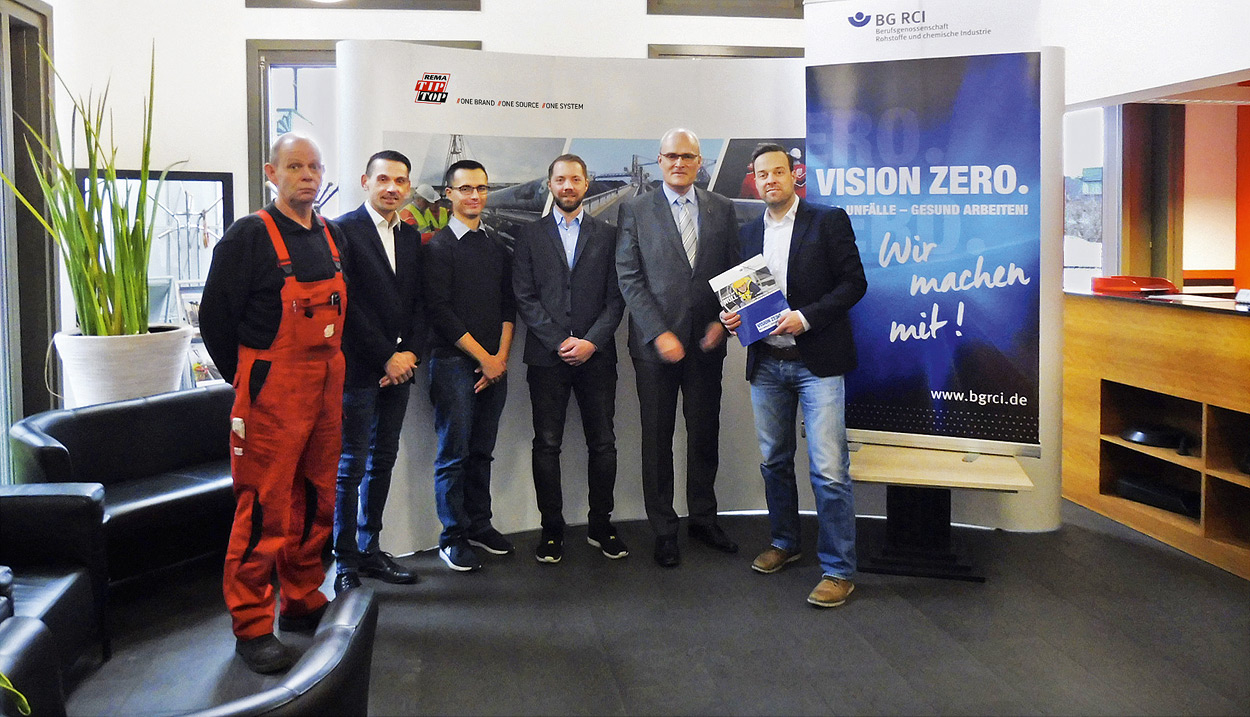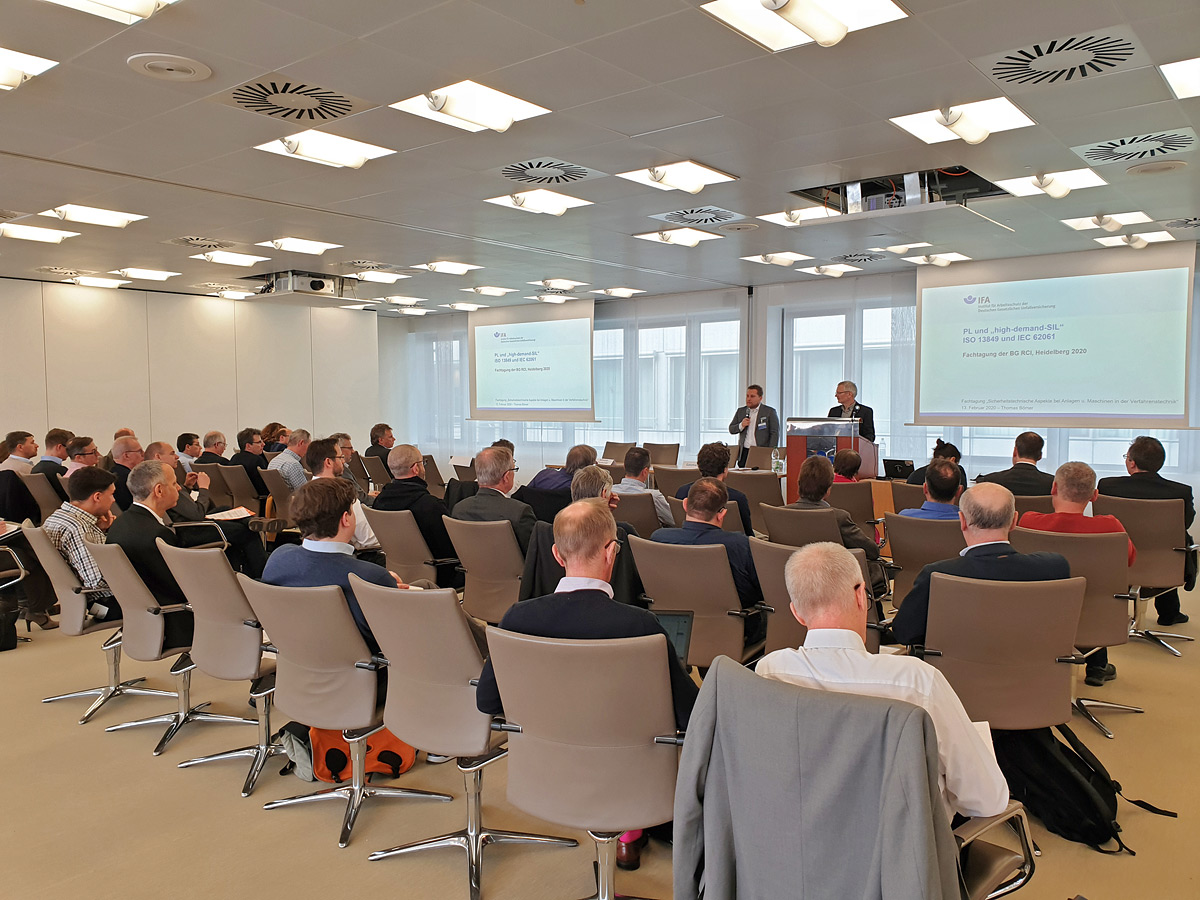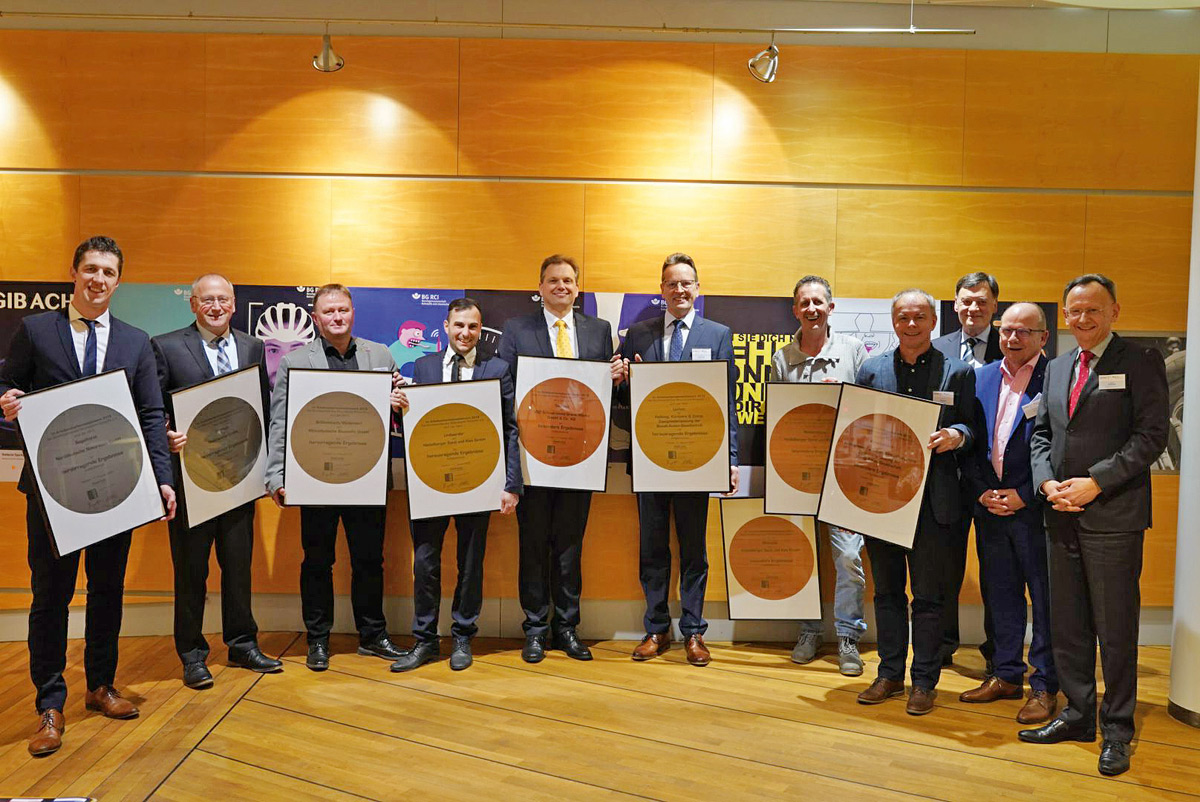Around 50 participants met in Heidelberg for a workshop by the name of “Safety-related aspects of plants and machines in process engineering” for the purpose of discussing issues surrounding hazard assessments, risk assessments and safety reviews. The workshop talks are available to download free of charge from the BG RCI’s expertise portal (www.bgrci.de/fachwissen-portal/themenspektrum/anlagensicherheit/workshop-sicherheitstechnische-aspekte-bei-anlagen-und-maschinen-in-der-verfahrenstechnik).
Twelve companies from the “natural stone” and “gravel/sand” industries were presented with awards from the Bundesverband Mineralische Rohstoffe e. V. (MIRO), an association representing companies from the sand, gravel, quartz sand and natural stone industries, at this year’s occupational safety competition held by the association. Walter Nelles, Vice General Manager of MIRO, provided a summary of the awards ceremony.
VISION ZERO cooperation agreements
At the heart of the cooperation agreements between the Social Accident Insurance Institution for the Raw Materials and Chemical Industry (BG RCI), Heidelberg/Germany, and its member companies is the public commitment to the VISION ZERO preventive strategy. The aim is to establish greater health and safety in their operations. The BG RCI helps member businesses, associations and unions to implement VISION ZERO in their companies. Good examples show the way; mistakes are learning opportunities!

Fig. 1. Representatives from RTTW and the BG RCI at the signing of the contract (from left): Stefan Grobbing (Works Council RTTW), Thorsten Ettelt (Supervisor BG RCI), Stefano Mercurio (Occupational Safety Specialist in training RTTW), Rüdiger Mertens (Authorised Representative RTTW), Dieter Bärhausen (Prevention Area Manager Bochum/Cologne BG RCI) and Sebastian Weber (CEO RTTW). Photo: RTTW
New VISION ZERO cooperation partners of the BG RCI are (Figure 1):
- REMA TIP TOP West GmbH (RTTW), a global system supplier of services and products in material processing and surface protection technology, as well as tyre repair. REMA TIP TOP generated a turnover of more than 1.1 bn € by the end of the 2018 business year. The company has over 7,400 employees around the world. “For our service business and the high-quality work we do for our customers, healthy employees are the elementary component for long-term success,” says Sebastian Weber, CEO of RTTW. Dieter Bärhausen, Prevention Area Manager Division 2 (Chemicals – Paper – Sugar) of the BG RCI, also believes REMA TIP TOP is on the right track: “Those who think about the safety and health of their employees from the outset achieve more for their company and their economic success in the long term.”
- the German Concrete Components interest group (Deutsche Betonbauteile), an amalgamation of eight regional associations and four national specialist organisations, which advises on current issues surrounding the German concrete parts industry and develops industry positions. “Occupational health and safety have been intensively promoted by the leading associations of German Concrete Components for many decades now,” states Jens Uwe Pott, representative of the association. “The cooperation agreement is the next logical step for further advancing the prevention of workplace accidents and work-related health hazards at the member companies,” continues Pott. “Health and safety need to be recognised as elementary values of all people, and managers and employees at businesses must fulfil their responsibilities. Ultimately, this is how to turn the vision of an accident-free working life more and more into a reality,” explains Wolfgang Pichl, Deputy Prevention Officer at the BG RCI.
Safety-related aspects of plants and machines
Hazard assessment, risk assessment, safety review – if you look in various different regulations, similar terms crop up to describe the preventive examination of risks and hazards. But is an identical process always behind them? Do they cover the same target audience and derived concepts? Around 50 participants met in Heidelberg for a workshop by the name of “Safety-related aspects of plants and machines in process engineering”, during which the aforementioned questions were answered, as well as others (Figure 2).

Fig. 2. Around 50 participants met in Heidelberg for a workshop by the name of “Safety-related aspects of plants and machines in process engineering”. Photo: BG RCI
In process plants, various different requirements for managing hazards and risks need to be met in order for machines, materials and processing equipment to work together correctly. Since different guidelines need to be observed here, there may be situations in which regulations and requirements compete with one another.
To raise awareness of these issues, the “Raw materials and chemical industry” division of the German Social Accident Insurance (Deutsche Gesetzliche Unfallversicherung, DGUV), under the aegis of the “Process engineering and pressurised systems” field, in close collaboration with the “Machines in the chemical industry” field, invited experts to examine the current occupational safety regulations, plant safety and machine safety from their perspective.
“Assessing hazards and risks” was the umbrella term for the first group of topics, chaired by Joachim Sommer from the Plant and Process Safety department at the BG RCI. Firstly, Bernhard Labestin, Head of EHS at Abbott in Wiesbaden, looked at the requirements of the Technical Rules for Industrial Safety TRBS 1111 with regard to hazard assessments for work equipment. Andreas Thies, Head of Occupational and Plant Safety at Merck in Darmstadt, explained risk assessments in process reliability and the specific perspective of the German Industrial Accident Regulation (Störfall-Verordnung). To conclude the event, Thomas Demmer from BASF in Ludwigshafen explained the requirements set out in the Machinery Directive on the basis of the risk assessment for machines.
One aspect of considering measures is that the concepts for safety equipment in control technology in the standards for intended operation and for preventing deviating process statuses are based on different philosophies. In the group of topics by the name of “Protection concepts with process control technology equipment”, chaired by Sebastian Gatzmanga from the Machine and Product Safety department at the BG RCI, Thomas Bömer, Head of the Intelligent Technical Systems and World of Work department at the DGUV Institute for Occupational Protection, and Gregor Schmitt-Pauksztat, Head of Modelling & Technical Safety at Bayer in Leverkusen, outlined the differences between the standards ISO 13849 for categorising the performance level for machines and IEC 61511 for classifying the safety integrity level for process plants.
The third group of topics “Aspects of procurement and installation” was chaired by Ulrike Timmer from the Machine and Product Safety department at the BG RCI. To examine this issue, various status papers were used which could be interpreted in different ways, leading to varying results depending on the interests and point of view. Ursula Aich, Occupational Protection and Environment department Wiesbaden of the District Government of Darmstadt, reported about the background to the announcement “Procurement of work equipment” by the Occupational Safety. Thomas Martin, Head of the Instrumentation & Control department at ThyssenKrupp Industrial Solutions in Dortmund, presented the safety-relevant wiring when installing package units in a process plant using a compressor as an example.
A “gallery walk” gave the specialists in machine safety, plant safety, process reliability and measurement and control technology from member businesses of the BG RCI, occupational safety and approval authorities and monitoring organisations plenty of opportunity to discuss with one another.
In his summary to conclude the event, Jost-Peter Sonnenberg, Head of the Centre of Excellence for Technical Safety at the BG RCI, said he was pleased with the sharing of experience and ideas that had taken place, which required awareness of different issues and approaches. There are plans to continue this series of events.
Awards for occupational safety
Twelve companies from the “natural stone” and “gravel/sand” industries were presented with awards from the Bundesverband Mineralische Rohstoffe e.V. (MIRO), an association representing companies from the sand, gravel, quartz sand and natural stone industries, at this year’s occupational safety competition held by the association. The awards were presented as part of the protecT forum hosted by the BG RCI in Potsdam/Germany.
MIRO supports its member companies in their efforts to improve occupational health and safety. One aspect of this is the occupational safety competition, which is designed to motivate employees at the companies to ensure safe conduct at the workplace. Participation fosters a sense of unity among staff, encourages them to think about their own safety, results in a change of conduct and is therefore motivation to improve safety. Since all staff are assessed collectively, employees are more likely to correct their colleagues in the event of poor conduct in order to be successful in the competition.
Arthur Binkowski, representative of the stone industry in the Prevention Advisory Committee for the “Construction materials – Stone – Earth” industry of the BG RCI and member of the “Occupational Safety” Committee at the Bundesverband Mineralische Rohstoffe, an association for mineral raw materials, gave the speech congratulating the competition winners. A fitting motto, “Road safety. Many routes – one goal”, was chosen for this year’s protecT forum, one which can be transferred to many of life’s other issues. “The current climate protection debate, demographic change, Work 4.0 and currently the response to the coronavirus in some states is showing us on a daily basis that many different routes can be taken to achieve the same goal. This is all the more relevant to our issues of health and safety at the workplace, as occupational protection in Germany is undergoing a transformation, with the signs of this transformation being unmissable.”
When it comes to occupational safety, nothing remains as it was. Nevertheless, complaining about these turbulent times serves no purpose. On the contrary, occupational safety experts should use these opportunities and adopt many (new) approaches to achieve their aims. A new approach here could be, e. g., reinventing operational prevention in a different way. We all can and should understand and implement the concept of prevention in such a way that mistakes are not made in the first place.
Businesses in the stone industry were presented with gold, silver or bronze awards separately for the “natural stone” and “gravel/sand” industries (Figure 3).

Fig. 3. The award-winners from the “natural stone” and “gravel/sand” industries at this year’s occupational safety competition received gold, silver or bronze awards from the MIRO. Photo: BG RCI, Norman Rath
Gold:
- Hollweg, Kümpers & Comp., subsidiary of Basalt-Actien-Gesellschaft, Ueffeln plant;
- Heidelberger Sand und Kies GmbH, Lindwerder gravel works.
Silver:
- Alfred Dörflinger GmbH, granite works and quarry;
- Norddeutsche Naturstein GmbH, Segelhorst plant;
- Mitteldeutsche Baustoffe GmbH, Schladebach gravel works;
- Quarzwerke GmbH, Gambach plant.
Bronze:
- Hartsteinwerke Bayern-Mitteldeutschland, subsidiary of Basalt-Actien-Gesellschaft, Hirschentanz plant;
- Wilhelm Geiger GmbH & Co. KG, Leukersdorf plant;
- VSG Schwarzwald-Granit-Werke GmbH & Co. KG,
Seebach plant; - Quarzsandwerk Wellmersdorf GmbH & Co. KG,
Wellmersdorf plant; - Heidelberger Sand und Kies GmbH, Bittstädt plant;
- Heidelberger Sand und Kies GmbH, Niederlehme plant.
The safety index (SI), which gives the number of hours worked by commercial employees (divided by 1,000) referenced to the number of accidents at work (trade) is relevant to the occupational safety competition. If no accidents occurred at the company, accident-free hours accrued in the previous year(s) will also be taken into consideration, in other words credited to the company. This “credit” will cease to be updated, in other words will no longer be included in the assessment, as soon as another industrial accident occurs. This accumulation also gives smaller member factories the opportunity to continuously increase the safety index so that they can be considered in the awards.